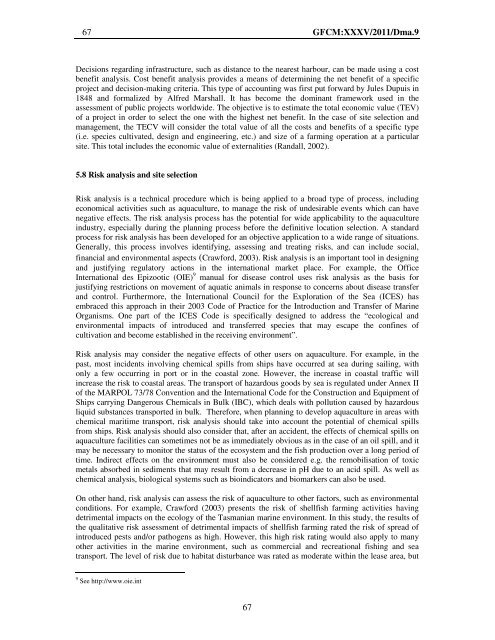Site selection and carrying capacity in Mediterranean ... - FAO Sipam
Site selection and carrying capacity in Mediterranean ... - FAO Sipam
Site selection and carrying capacity in Mediterranean ... - FAO Sipam
Create successful ePaper yourself
Turn your PDF publications into a flip-book with our unique Google optimized e-Paper software.
67 GFCM:XXXV/2011/Dma.9<br />
Decisions regard<strong>in</strong>g <strong>in</strong>frastructure, such as distance to the nearest harbour, can be made us<strong>in</strong>g a cost<br />
benefit analysis. Cost benefit analysis provides a means of determ<strong>in</strong><strong>in</strong>g the net benefit of a specific<br />
project <strong>and</strong> decision-mak<strong>in</strong>g criteria. This type of account<strong>in</strong>g was first put forward by Jules Dupuis <strong>in</strong><br />
1848 <strong>and</strong> formalized by Alfred Marshall. It has become the dom<strong>in</strong>ant framework used <strong>in</strong> the<br />
assessment of public projects worldwide. The objective is to estimate the total economic value (TEV)<br />
of a project <strong>in</strong> order to select the one with the highest net benefit. In the case of site <strong>selection</strong> <strong>and</strong><br />
management, the TECV will consider the total value of all the costs <strong>and</strong> benefits of a specific type<br />
(i.e. species cultivated, design <strong>and</strong> eng<strong>in</strong>eer<strong>in</strong>g, etc.) <strong>and</strong> size of a farm<strong>in</strong>g operation at a particular<br />
site. This total <strong>in</strong>cludes the economic value of externalities (R<strong>and</strong>all, 2002).<br />
5.8 Risk analysis <strong>and</strong> site <strong>selection</strong><br />
Risk analysis is a technical procedure which is be<strong>in</strong>g applied to a broad type of process, <strong>in</strong>clud<strong>in</strong>g<br />
economical activities such as aquaculture, to manage the risk of undesirable events which can have<br />
negative effects. The risk analysis process has the potential for wide applicability to the aquaculture<br />
<strong>in</strong>dustry, especially dur<strong>in</strong>g the plann<strong>in</strong>g process before the def<strong>in</strong>itive location <strong>selection</strong>. A st<strong>and</strong>ard<br />
process for risk analysis has been developed for an objective application to a wide range of situations.<br />
Generally, this process <strong>in</strong>volves identify<strong>in</strong>g, assess<strong>in</strong>g <strong>and</strong> treat<strong>in</strong>g risks, <strong>and</strong> can <strong>in</strong>clude social,<br />
f<strong>in</strong>ancial <strong>and</strong> environmental aspects (Crawford, 2003). Risk analysis is an important tool <strong>in</strong> design<strong>in</strong>g<br />
<strong>and</strong> justify<strong>in</strong>g regulatory actions <strong>in</strong> the <strong>in</strong>ternational market place. For example, the Office<br />
International des Epizootic (OIE) 9 manual for disease control uses risk analysis as the basis for<br />
justify<strong>in</strong>g restrictions on movement of aquatic animals <strong>in</strong> response to concerns about disease transfer<br />
<strong>and</strong> control. Furthermore, the International Council for the Exploration of the Sea (ICES) has<br />
embraced this approach <strong>in</strong> their 2003 Code of Practice for the Introduction <strong>and</strong> Transfer of Mar<strong>in</strong>e<br />
Organisms. One part of the ICES Code is specifically designed to address the “ecological <strong>and</strong><br />
environmental impacts of <strong>in</strong>troduced <strong>and</strong> transferred species that may escape the conf<strong>in</strong>es of<br />
cultivation <strong>and</strong> become established <strong>in</strong> the receiv<strong>in</strong>g environment”.<br />
Risk analysis may consider the negative effects of other users on aquaculture. For example, <strong>in</strong> the<br />
past, most <strong>in</strong>cidents <strong>in</strong>volv<strong>in</strong>g chemical spills from ships have occurred at sea dur<strong>in</strong>g sail<strong>in</strong>g, with<br />
only a few occurr<strong>in</strong>g <strong>in</strong> port or <strong>in</strong> the coastal zone. However, the <strong>in</strong>crease <strong>in</strong> coastal traffic will<br />
<strong>in</strong>crease the risk to coastal areas. The transport of hazardous goods by sea is regulated under Annex II<br />
of the MARPOL 73/78 Convention <strong>and</strong> the International Code for the Construction <strong>and</strong> Equipment of<br />
Ships <strong>carry<strong>in</strong>g</strong> Dangerous Chemicals <strong>in</strong> Bulk (IBC), which deals with pollution caused by hazardous<br />
liquid substances transported <strong>in</strong> bulk. Therefore, when plann<strong>in</strong>g to develop aquaculture <strong>in</strong> areas with<br />
chemical maritime transport, risk analysis should take <strong>in</strong>to account the potential of chemical spills<br />
from ships. Risk analysis should also consider that, after an accident, the effects of chemical spills on<br />
aquaculture facilities can sometimes not be as immediately obvious as <strong>in</strong> the case of an oil spill, <strong>and</strong> it<br />
may be necessary to monitor the status of the ecosystem <strong>and</strong> the fish production over a long period of<br />
time. Indirect effects on the environment must also be considered e.g. the remobilisation of toxic<br />
metals absorbed <strong>in</strong> sediments that may result from a decrease <strong>in</strong> pH due to an acid spill. As well as<br />
chemical analysis, biological systems such as bio<strong>in</strong>dicators <strong>and</strong> biomarkers can also be used.<br />
On other h<strong>and</strong>, risk analysis can assess the risk of aquaculture to other factors, such as environmental<br />
conditions. For example, Crawford (2003) presents the risk of shellfish farm<strong>in</strong>g activities hav<strong>in</strong>g<br />
detrimental impacts on the ecology of the Tasmanian mar<strong>in</strong>e environment. In this study, the results of<br />
the qualitative risk assessment of detrimental impacts of shellfish farm<strong>in</strong>g rated the risk of spread of<br />
<strong>in</strong>troduced pests <strong>and</strong>/or pathogens as high. However, this high risk rat<strong>in</strong>g would also apply to many<br />
other activities <strong>in</strong> the mar<strong>in</strong>e environment, such as commercial <strong>and</strong> recreational fish<strong>in</strong>g <strong>and</strong> sea<br />
transport. The level of risk due to habitat disturbance was rated as moderate with<strong>in</strong> the lease area, but<br />
9 See http://www.oie.<strong>in</strong>t<br />
67
















